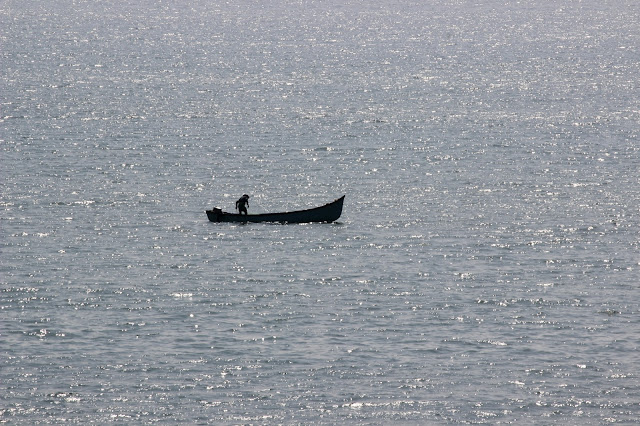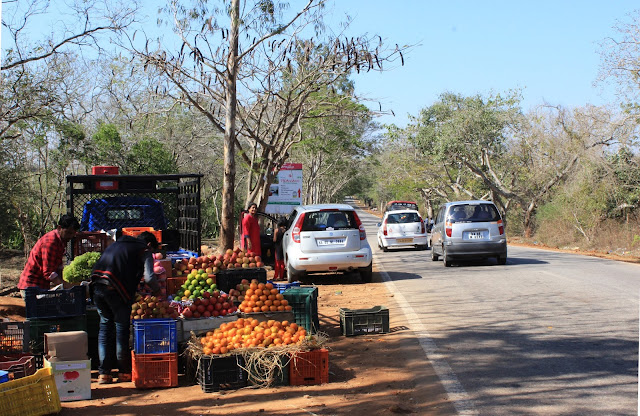The bastions were there ,so were the cannons,the barracks ,dungeons ,prisons ,ammunition rooms , secret tunnels,cellars and of course the many tales.It was all there,the stage was set,so I could now let my imagination run wild,of scenes that would have happened here few centuries ago.Fleets of ships waiting to be loaded with spices from the mainland,soldiers marching in their boots inside the fort to keep themselves ready for any sudden attack,horses being cleaned and fed in the stables,change of the guards at the fort gates and the bastions.The days must have been eventful inside the huge laterite walls of this very important fort in the Malabar.

 |
| The main door of the fort(note the spikes) |
The history of Saint Angelo's Fort
After the Chera dynasty ,the Malabar region got divided into many territories ,amongst whom the Kolatharis were strong in the north and the Zamorins were established in the south. .The Kolathiris were the ones who first entered into an alliance with the Portuguese,in order to become more wealthy and powerful.They had done this as the Zamorins (their rivals )had established themselves with the help of the Arabs.The king of Portugal sent Don Francisco De Almeida as the first Portuguese viceroy in India,who built the St Angelo's Fort.The fort was planned to be used as a garrison for the navy and to help in the spice trade.But the Portuguese soon started making their settlement there and did not merely continue their spice trade.Much to the annoyance of local rulers they started forcibly converting the locals to their religion.The Kolathiris and the Zamorins joined hands against the PortugueseThe Zamorins attacked the fort but were defeated.After the naval battle of Diu the portugeese started losing their foothold and lost the fort to the Dutch.The fort remained in the hands of the Dutch for more than a century .They renovated the fort mostly like how it is now.but later sold it to the Arakkal king Ali Raja,from whom the fort was finally taken over by the British.
 |
| The moat at the entrance from the bridge |
The moat at the entrance of the fort provided a protective mechanism to the fort,it connected the Arabian sea in the east to the Mapilla bay in the west.
 |
| Cannon lined up in the well laid out gardens inside the fort |
 |
| The prison seen from the walls of the fort |
 |
| The chapel still remains ,built by the Portuguese and the oil lamp lighthouse used during those days can be seen behind the chapel |
The chapels and the prisons,remains of which can be seen today were built by the Portugeese. Much of the Portuguese structure were brought down by the Dutch.They built bastions named Hollandia,Zeelandia and Frieshlandia,as is obvious from the names.The ammunition rooms were made by the Dutch.And then the British,who made the stables ,the dungeons ,the cellars and the armory.Once seized from the Dutch the British used it as their chief military station in the Malabar till Independence.


The pictures above show the cannon balls kept out in the sun to dry probably after some chemical treatment,when we were visiting the place.An employee from the archaeological department was also seen cleaning the cannon balls .Approximately 12000 of them,these cannon balls,many of which were solid and quite a few even hollow, in different sizes were unearthed in 2015 when workers were digging the place to lay cables for a light and sound show recently set up in the fort premises.The cannon balls were found just one feet below the surface which suggests ,according to the
archaeological department ,that they were discarded.
 |
| The stairs leading up to the fort walls |
 |
| The stables and the barracks down from the fort walls |
The picture above is a view of the Mapilla bay from top of the fort .It owes its name to the Arab influence in the place ,with whom the local rulers were engaged in the spice trade.On one side of this Bay is the fort and on the other side is the Arakkal Palace ,the palace of the only Muslim rulers of the Malabar.The king of the Arrakal rulers ,Ali Raja and his queen held a place of prominence in the political scenario of erstwhile Cannanore,but that is a different story altogether.As of now,I could not stop clicking the picturesque Mapilla bay,following are what my lens could capture for you.
 |
| A cannon directed towards the sea in one of the bastions in the fort wall |
 |
| The death stone of one of the dutch commandments wife and two children |
 |
| Add caption |
The Arabian sea gulfs in along the wall of the fort,creating a beautiful scenery.The cliff end of the Fort as seen from the top of the stables.A 360 degree view of the sea and the Mapilla Bay on the other side is simply amazing.
 |
| Inside view of the stables |
 |
| An entrance to the fort through a moat straight from the Arabian sea, can now be seen blocked. |
The picture above suggests that small boats probably meant for loading ships stranded in the sea ,were loaded from these places inside the fort.
 |
| The cliff end of the fort |
A lot of time can be spent at the cliff end of the fort.There are some vendors here as well as in front of the chapel,selling snacks and icecreams. Apart from being an ideal destination for historians and nature lovers ,this place is a photographers delight.
 |
| A secret exit or entrance from the fort can be seen at the distance and the watch tower can be seen above it |
 |
| The spacious inside o f the Fort |

The St Angelos Fort fort is about 3 kms from Kannur.It is visited by the tourists and the locals alike.I guess the locals treat this fort as a park ,as there is a lot of greenery in and around the place.The gardens and lawns inside are very well maintained by the archaeological department.One can easily spend 3 to 4 hours here.The archaeological department has an office inside the fort which can be approached for further guidance .The fort is open to visitors from 8 in the morning to 6 in the evening ,but a visit during broad daylight is recommended for the best views around the place.A light and sound show is held here in the evening.There is no entry fees but a nominal parking fees are charged.There are no charges for cameras too .History buffs or not ,this place is a must visit for all who visit Kannur.
The railway station at Kannur is also well connected to all parts of India.The nearest airports are at Calicut and Mangalore,while the new airport coming up at Kannur is expected to begin commercial operations in mid 2017.Kannur is on national highway 66 between Kozhikode and Mangalore.
.




















































